steering TOYOTA HIGHLANDER HYBRID 2012 XU40 / 2.G Manual PDF
[x] Cancel search | Manufacturer: TOYOTA, Model Year: 2012, Model line: HIGHLANDER HYBRID, Model: TOYOTA HIGHLANDER HYBRID 2012 XU40 / 2.GPages: 636, PDF Size: 11.26 MB
Page 522 of 636
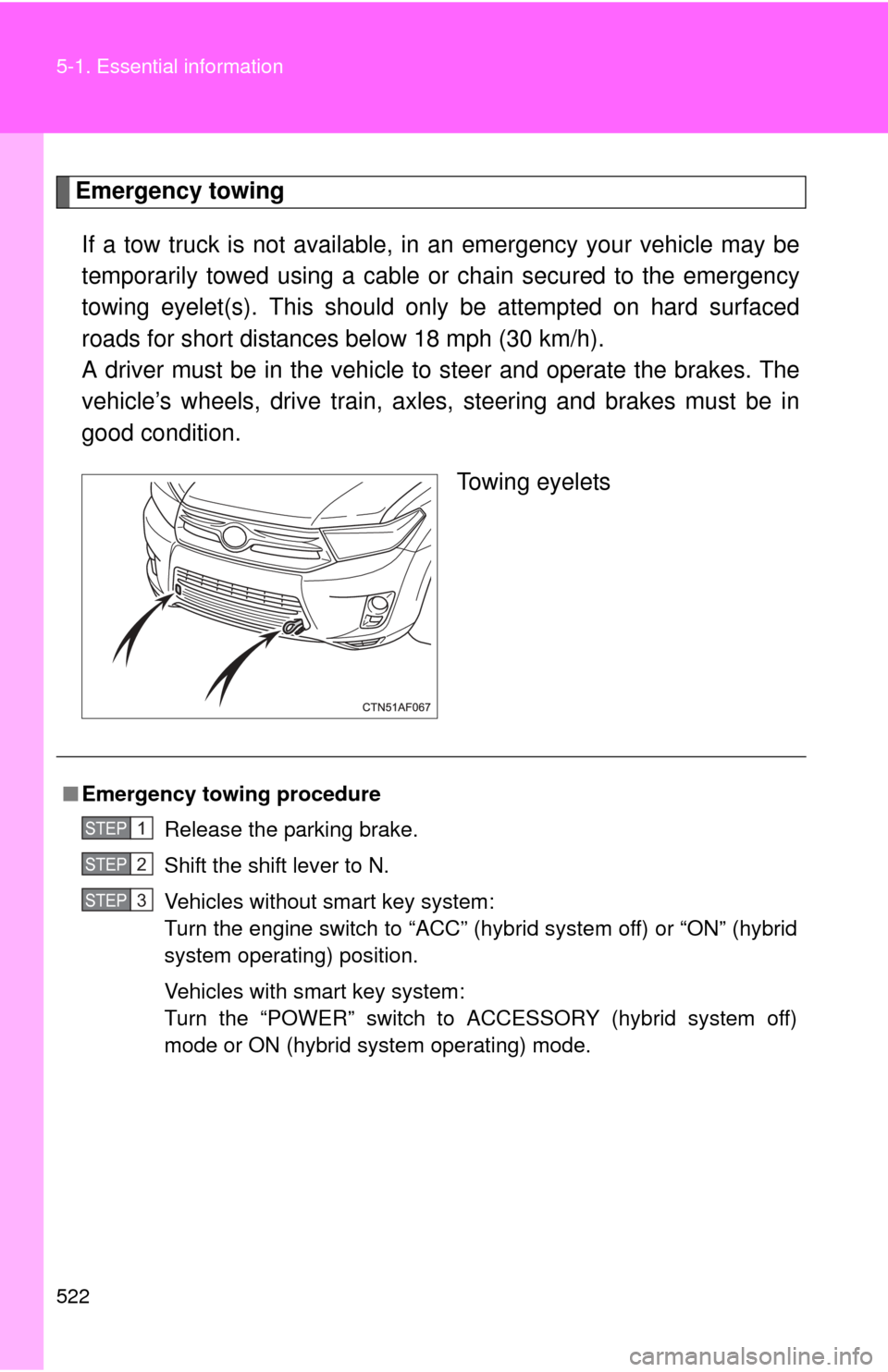
522 5-1. Essential information
Emergency towingIf a tow truck is not available, in an emergency your vehicle may be
temporarily towed using a cable or chain secured to the emergency
towing eyelet(s). This should only be attempted on hard surfaced
roads for short distances below 18 mph (30 km/h).
A driver must be in the vehicle to steer and operate the brakes. The
vehicle’s wheels, drive train, axles, steering and brakes must be in
good condition.
Towing eyelets
■Emergency towin g procedure
Release the parking brake.
Shift the shift lever to N.
Vehicles without smart key system:
Turn the engine switch to “ACC” (hybrid system off) or “ON” (hybrid
system operating) position.
Vehicles with smart key system:
Turn the “POWER” switch to ACCESSORY (hybrid system off)
mode or ON (hybrid system operating) mode.
STEP1
STEP2
STEP3
Page 523 of 636
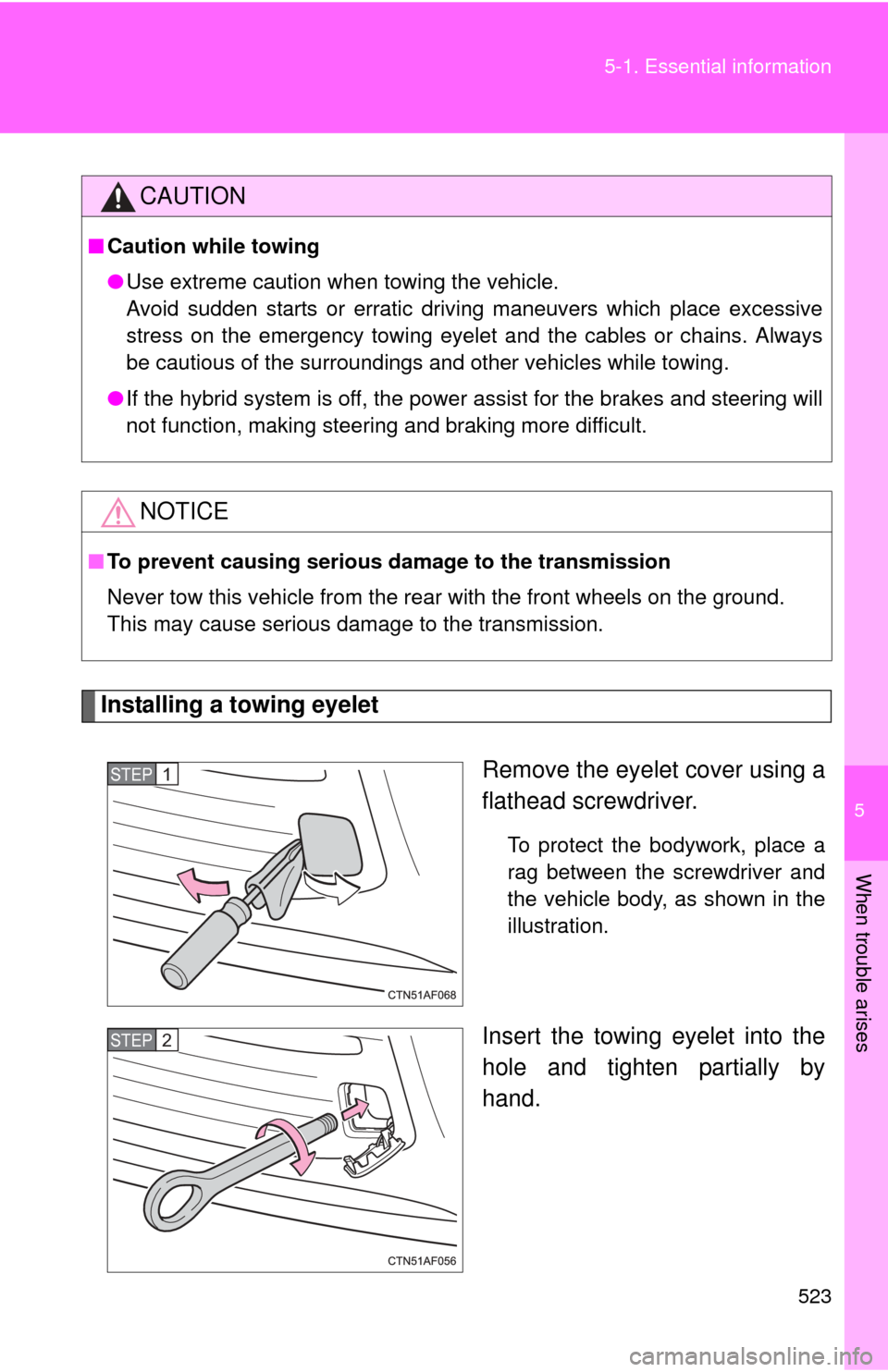
5
When trouble arises
523
5-1. Essential information
Installing a towing eyelet
Remove the eyelet cover using a
flathead screwdriver.
To protect the bodywork, place a
rag between the screwdriver and
the vehicle body, as shown in the
illustration.
Insert the towing eyelet into the
hole and tighten partially by
hand.
CAUTION
■Caution while towing
●Use extreme caution when towing the vehicle.
Avoid sudden starts or erratic driving maneuvers which place excessive
stress on the emergency towing eyelet and the cables or chains. Always
be cautious of the surroundings and other vehicles while towing.
● If the hybrid system is off, the power assist for the brakes and steering will
not function, making steering and braking more difficult.
NOTICE
■To prevent causing serious dama ge to the transmission
Never tow this vehicle from the rear with the front wheels on the ground.
This may cause serious damage to the transmission.
STEP1
STEP2
Page 530 of 636
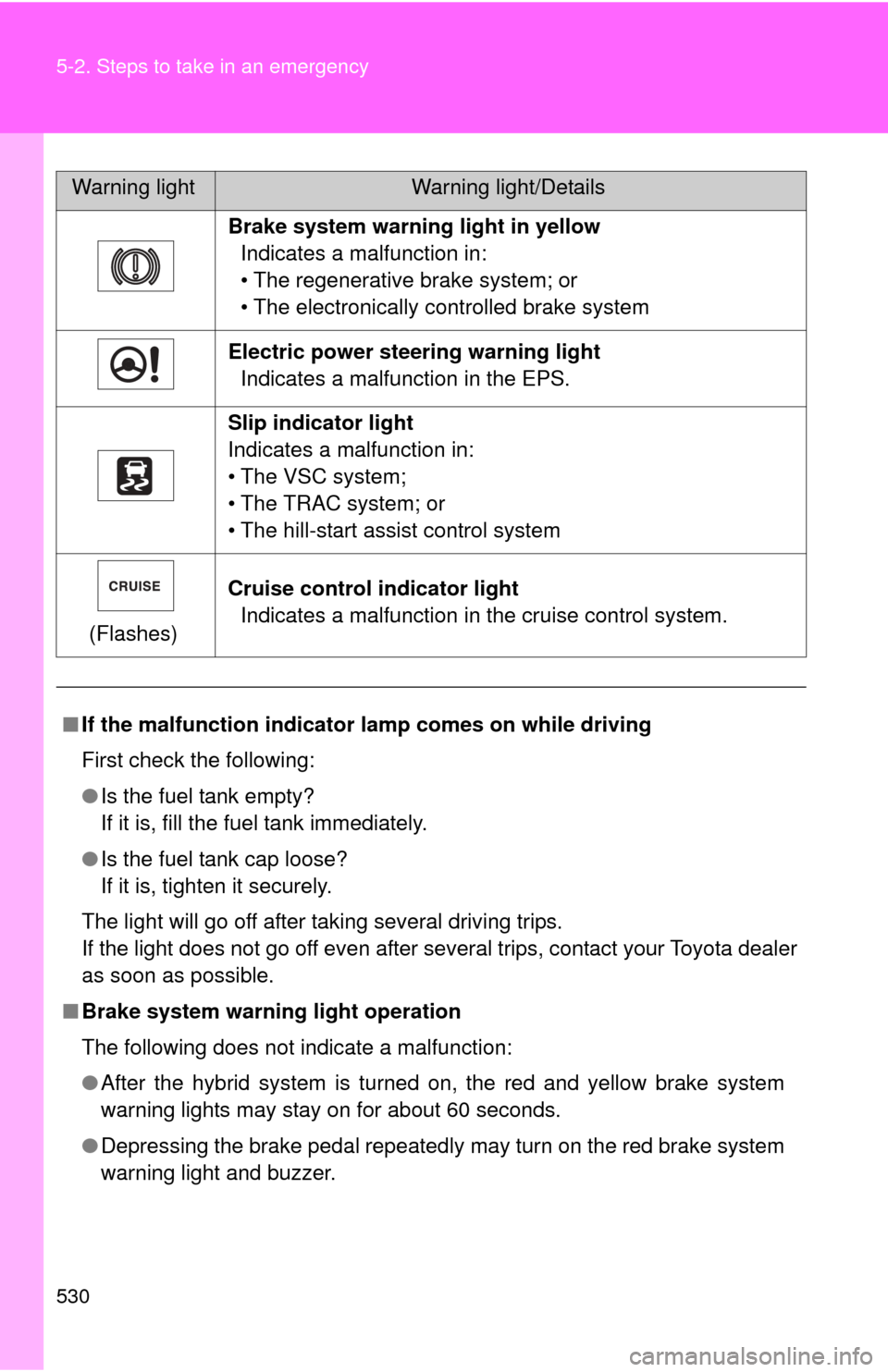
530 5-2. Steps to take in an emergency
Brake system warning light in yellowIndicates a malfunction in:
• The regenerative brake system; or
• The electronically controlled brake system
Electric power steering warning light Indicates a malfunction in the EPS.
Slip indicator light
Indicates a malfunction in:
• The VSC system;
• The TRAC system; or
• The hill-start assist control system
(Flashes) Cruise control indicator light
Indicates a malfunction in the cruise control system.
■ If the malfunction indicator lamp comes on while driving
First check the following:
● Is the fuel tank empty?
If it is, fill the fuel tank immediately.
● Is the fuel tank cap loose?
If it is, tighten it securely.
The light will go off after taking several driving trips.
If the light does not go off even after several trips, contact your Toyota dealer
as soon as possible.
■ Brake system warning light operation
The following does not indicate a malfunction:
●After the hybrid system is turned on, the red and yellow brake system
warning lights may stay on for about 60 seconds.
● Depressing the brake pedal repeatedly may turn on the red brake system
warning light and buzzer.
Warning lightWarning light/Details
Page 536 of 636
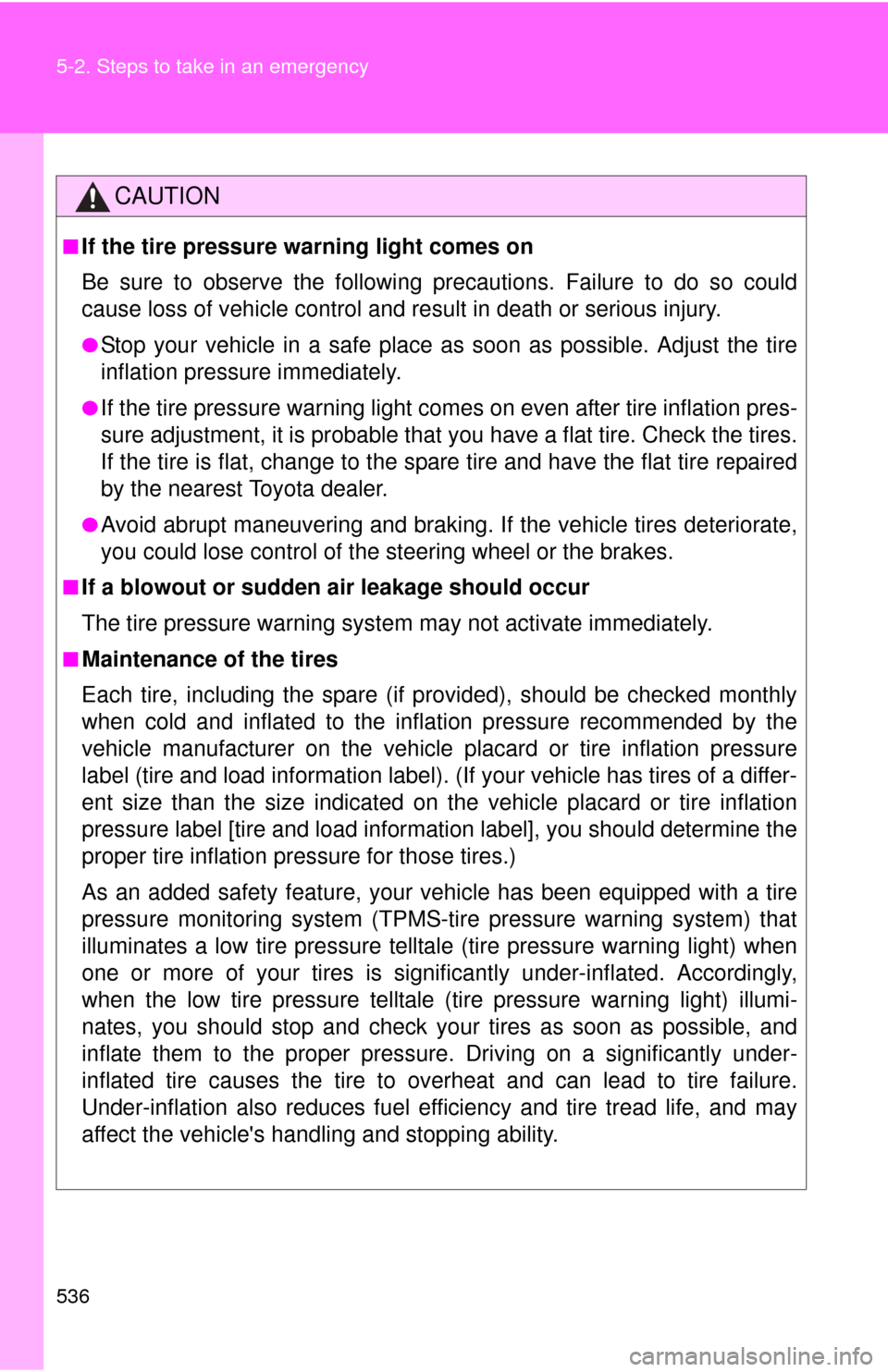
536 5-2. Steps to take in an emergency
CAUTION
■If the tire pressure warning light comes on
Be sure to observe the following precautions. Failure to do so could
cause loss of vehicle control and re sult in death or serious injury.
●Stop your vehicle in a safe place as soon as possible. Adjust the tire
inflation pressure immediately.
●If the tire pressure warning light comes on even after tire inflation pres-
sure adjustment, it is pr obable that you have a flat tire. Check the tires.
If the tire is flat, change to the spare tire and have the flat tire repaired
by the nearest Toyota dealer.
●Avoid abrupt maneuvering and braking. If the vehicle tires deteriorate,
you could lose control of the steering wheel or the brakes.
■If a blowout or sudden air leakage should occur
The tire pressure warning syste m may not activate immediately.
■Maintenance of the tires
Each tire, including the spare (if provided), should be checked monthly
when cold and inflated to the inflation pressure recommended by the
vehicle manufacturer on the vehicle placard or tire inflation pressure
label (tire and load information label). (If your vehicle has tires of a differ-
ent size than the size indicated on the vehicle placard or tire inflation
pressure label [tire and load information label], you should determine the
proper tire inflation pr essure for those tires.)
As an added safety feature, your vehicle has been equipped with a tire
pressure monitoring system (TPMS-ti re pressure warning system) that
illuminates a low tire pressure telltal e (tire pressure warning light) when
one or more of your tires is significantly under-inflated. Accordingly,
when the low tire pressu re telltale (tire pressure warning light) illumi-
nates, you should stop and check your tires as soon as possible, and
inflate them to the proper pressure. Driving on a significantly under-
inflated tire causes the tire to overheat and can lead to tire failure.
Under-inflation also reduces fuel effi ciency and tire tread life, and may
affect the vehicle's hand ling and stopping ability.
Page 552 of 636

552
5-2. Steps to take in an emergency
If the hybrid system will not start
Reasons for the hybrid system not starting vary depending on the
situation. Check the following a nd perform the appropriate proce-
dure:
■ The hybrid system will not start, even though the correct
starting procedure is being followed. ( P. 179, 184)
One of the following may be the cause of the problem.
● The electronic key may not be functioning properly. ( P. 556)
● There may be a malfunction in the immobilizer system.
( P. 123)
● There may be a malfunction in the steering lock system.
● The hybrid system may be malfun ctioning due to an electrical
problem such as an open circuit or a blown fuse. However,
depending on the type of malf unction, an interim measure is
available to start the hybrid system. ( P. 553)
■ The interior lights and headlights are dim, or the horn does
not sound or sounds at a low volume.
One of the following may be the cause of the problem.
●The 12-volt battery may be discharged. ( P. 558)
● The 12-volt battery terminal c onnections may be loose or cor-
roded.
Page 568 of 636

568 5-2. Steps to take in an emergency
CAUTION
■If the hybrid system has to be turned off while driving
● Power assist for the brakes and steering wheel will be lost, making the
brake pedal harder to depress and the steering wheel heavier to turn.
Decelerate as much as possible before turning off the hybrid system.
● Vehicles without a smart key system: Never attempt to remove the key, as
doing so will lock the steering wheel.
Vehicles with a smart key sys-
tem: Stop the hybrid system
by pressing and holding the
“POWER” switch for 3 consec-
utive seconds or more.
Stop the vehicle in a safe place by the road.
Press and hold for 3 seconds or more
STEP4
STEP5
Page 580 of 636

580 6-1. Specifications
Brakes
*1: Minimum pedal clearance when depressed with a force of 110 lbf (490 N,50 kgf) while the hybrid system is on.
*
2: Parking brake pedal travel when depressed with a force of 67 lbf (300 N, 31 kgf)
Steering
Pedal clearance*13.74 in. (95 mm) Min.
Pedal free play 0.04 0.08 in. (1 2 mm)
Brake pad wear limit 0.04 in. (1.0 mm)
Parking brake lining wear limit 0.04 in. (1.0 mm)
Parking brake pedal travel*28 10 clicks
Fluid type SAE J1703 or FMVSS No.116 DOT 3
Free playLess than 1.2 in. (30 mm)
Page 593 of 636

593
6-1. Specifications
6
Vehicle specifications
Warning: The temperature grades for this tire are established for a
tire that is properly inflated and not overloaded.
Excessive speed, underinflation, or
excessive loading, either sepa-
rately or in combination, can caus e heat buildup and possible tire fail-
ure.
Glossary of tire terminology
Tire related termMeaning
Cold tire inflation pres-
sure Tire pressure when the vehicle has been
parked for three hours or more, or has not
been driven more than 1 mile or 1.5 km under
that condition
Maximum inflation
pressure The maximum cold inflated
pressure to which a
tire may be inflated, s hown on the sidewall of
the tire
Recommended infla-
tion pressure Cold tire inflation pressure recommended by a
manufacturer
Accessory weight The combined weight (in excess of those stan-
dard items which may be replaced) of auto-
matic transmission, power steering, power
brakes, power windows, power seats, radio
and heater, to the extent that these items are
available as factory-installed equipment
(whether installed or not)
Curb weight The weight of a motor vehicle with standard
equipment, including the maximum capacity of
fuel, oil and coolant, and if so equipped, air
conditioning and additional weight optional
engine
Maximum loaded vehi-
cle weight The sum of:
(a) Curb weight
(b) Accessory weight
(c) Vehicle capacity weight
(d) Production options weight
Page 620 of 636
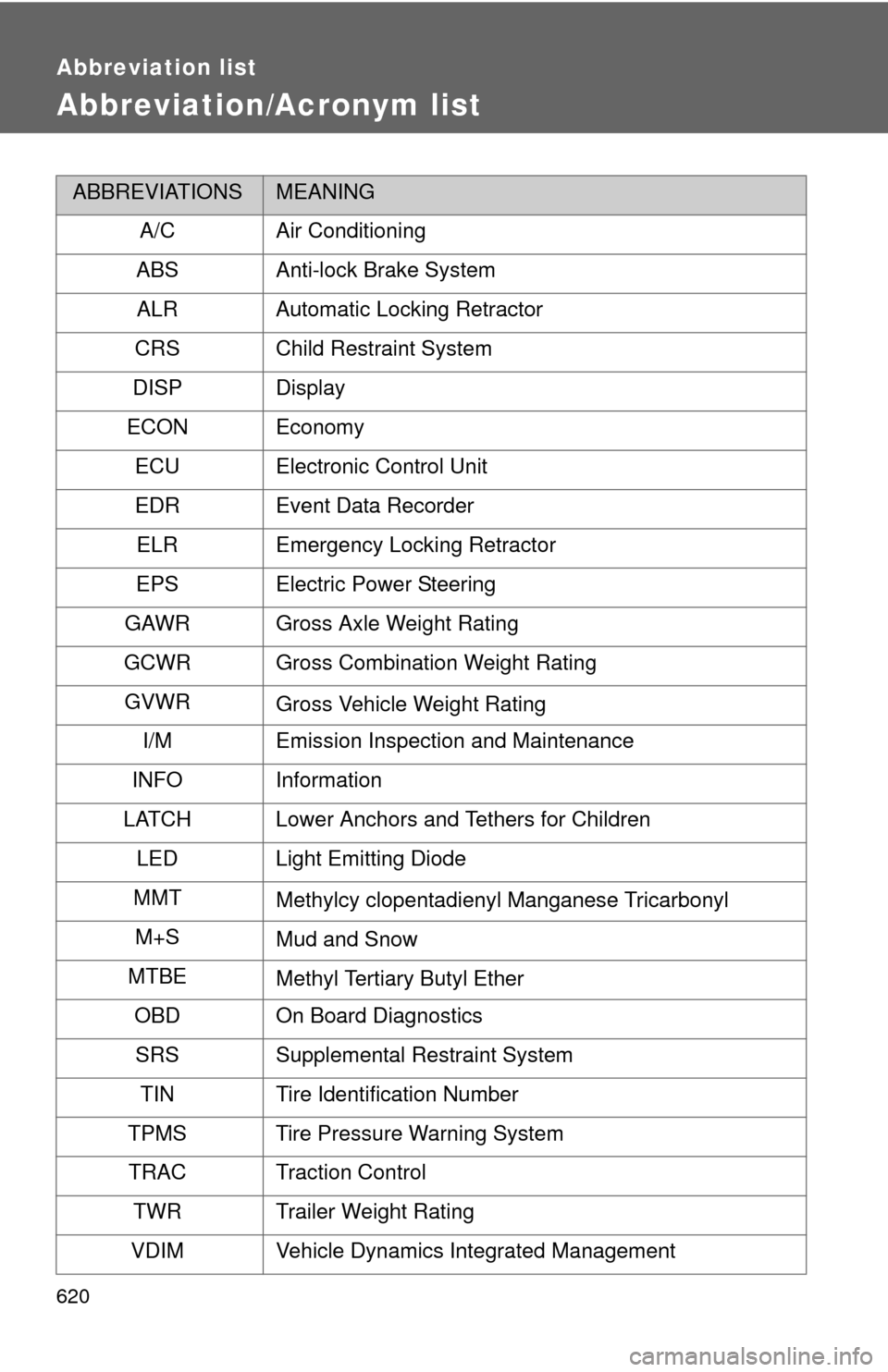
620
Abbreviation list
Abbreviation/Acronym list
ABBREVIATIONSMEANING
A/C Air Conditioning
ABS Anti-lock Brake System ALR Automatic Locking Retractor
CRS Child Restraint System
DISP Display
ECON Economy
ECU Electronic Control Unit
EDR Event Data RecorderELR Emergency Locking Retractor
EPS Electric Power Steering
GAWR Gross Axle Weight Rating
GCWR Gross Combination Weight Rating GVWR Gross Vehicle Weight Rating
I/M Emission Inspection and Maintenance
INFO Information
LATCH Lower Anchors and Tethers for Children
LED Light Emitting Diode
MMT Methylcy clopentadienyl Manganese Tricarbonyl
M+S Mud and Snow
MTBE Methyl Tertiary Butyl Ether
OBD On Board Diagnostics
SRS Supplemental Restraint System
TIN Tire Identification Number
TPMS Tire Pressure Warning System TRAC Traction Control
TWR Trailer Weight Rating
VDIM Vehicle Dynamics Integrated Management
Page 622 of 636

622
Alphabetical index
Alphabetical index
A/C ..................... 278, 284, 293, 296
ABS ........................................... 234
Air conditioning filter............... 491
Air conditioning systemAir conditioning filter .............. 491
Front automatic air conditioning system ............ 284
Front manual air conditioning system ............ 278
Rear automatic air
conditioning system ............ 296
Rear manual air conditioning system ............ 293
Airbags Airbag operating conditions............................ 136
Airbag precautions for your child ............................ 140
Airbag warning light............... 529
Curtain shield airbag
operating conditions............ 136
Curtain shield airbag
precautions ......................... 140
Front passenger occupant classification system ........... 145
General airbag precautions ......................... 140
Locations of airbags .............. 133
Modification and disposal
of airbags ............................ 144
Proper driving
posture ........................ 131, 140
Side airbag operating conditions............................ 136
Side airbag precautions ........ 140
SRS airbags .......................... 133
Alarm ......................................... 126
Antenna..................................... 312
Anti-lock brake system............ 234
Armrest ..................................... 426
Audio input ............................... 347 Audio system
Antenna................................. 312
Audio input ............................ 347
AUX port ............................... 347
CD player/changer ................ 315
iPod ....................................... 329
MP3/WMA disc ..................... 322
Optimal use ........................... 344
Portable music player ........... 347
Radio..................................... 308
Steering wheel audio switch.................................. 349
Type ...................................... 304
USB memory......................... 336
Automatic light control system .................................... 213
AUX port ................................... 347
Auxiliary box ........................... 413
Back-up lights Replacing light bulbs ............. 510
Wattage................................. 583
Back door Back door ................................ 70
Smart key system .. ................. 46
Wireless remote control .......... 59
Battery
Checking ............................... 473
Hybrid battery (traction battery) ................... 35
If the vehicle has a discharged 12-volt
battery................................. 558
Preparing and checking
before winter ....................... 251
Bluetooth
® audio ..................... 352
Bluetooth® phone .................... 368
Bottle holder............................. 412
A
B